A New Type of Crumb Rubber Asphalt Mixture: A Dry Process Design and Performance Evaluation
Abstract
:1. Introduction
2. Materials and Research Content
2.1. Materials
2.1.1. Asphalt
2.1.2. Aggregate and Filler
2.1.3. Preparation of a New Type of Crumb Rubber (CRT)
2.2. Research Contents
3. Gradation Design
3.1. Coarse and Fine Aggregate Design
3.1.1. Division of Coarse and Fine Aggregates
3.1.2. Coarse Aggregate Design
3.1.3. Fine Aggregate Design
3.2. Gradation Synthesis
3.2.1. Gradation Design
3.2.2. Aggregate Grading Optimization
3.3. Type of Crumb Rubber Asphalt Mixture (CRTAM) Design and Sample Preparation
3.3.1. Determination of Amount of CRT
3.3.2. Unequal Volume Replacement
3.4. Structural Determination
4. Performance Evaluation
4.1. Analysis of High-Temperature Performance
4.2. Analysis of Low-Temperature Performance
4.3. Analysis of Water Stability
5. Conclusions
- A skeletal intrusion compaction was used to optimize the grading of coarse aggregates and fine aggregates. Through the RCA test and a comparison of the standard grading, it was found that the gradation in the selected state was used as the synthetic gradation of the final skeleton compaction result;
- When the volume by equal volume was replaced, the low-temperature performance was increasingly better with an increase in the dosage. Considering the economy and specifications, 2% CRT was selected. Marshall tests were carried out on six gradations of 2% CRT by unequal volume replacement and two common intermittent gradations. The results indicated that all of them met the requirement of VCAmix ≤ VCADLC. It can be concluded that these eight gradations had a dense skeleton structure;
- For high-temperature stability, as an overall trend, DS first increased and then decreased with an increase in the substitution ratio and reached its maximum when the substitution ratio was 1.5. The integrated relative deformation rate introduced the K value, and when the substitution ratio was 1.5 and 0.5, the performance was relatively good. The water stability of the specimens was significantly improved by adding the CRT, and the water stability under 50 compaction conditions was better than that of the 34 compacted specimens under the same conditions;
- The low-temperature performance was characterized by the flexural strain energy density, which could simultaneously exhibit the bending strain and the bending strength. The value first increased and then decreased with an increase in the substitution ratio, and the low-temperature performance was best when the substitution value was 0.5;
- In terms of a comprehensive consideration of the various performances and economic benefits, the best CRT content of the proposed CRTAM was 2%, and the best substitution ratio was 0.5.
Author Contributions
Funding
Conflicts of Interest
References
- Fu, Z.; Sun, Q.; Li, J. Preparation and performance characterization of asphalt sustained-release capsules. Int. J. Pavement Res. Technol. 2018. [Google Scholar] [CrossRef]
- Ma, F.; Zhang, C. Road Performance of Asphalt binder Modified with Natural Rock Asphalt. Adv. Mater. Res. 2013, 634–638, 2729–2732. [Google Scholar] [CrossRef]
- Ahmadinia, E.; Zargar, M.; Karim, M.R.; Abdelaziz, M.; Shafigh, P. Using waste plastic bottles as additive for stone mastic asphalt. Mater. Des. 2011, 32, 4844–4849. [Google Scholar] [CrossRef]
- Venudharan, V.; Biligiri, K.P.; Sousa, J.B.; Way, G.B. Asphalt-rubber gap-graded mixture design practices: A state-of-the-art research review and future perspective. Road Mater. Pavement Des. 2017, 18, 730–752. [Google Scholar] [CrossRef]
- Moreno, F.; Sol, M.; Martin, J.; Perez, M.; Rubio, M.C. The effect of crumb rubber modifier on the resistance of asphalt mixes to plastic deformation. Mater. Des. 2013, 47, 274–280. [Google Scholar] [CrossRef]
- Gogoi, R.; Biligiri, K.P.; Das, N.C. Performance prediction analyses of styrene-butadiene rubber and crumb rubber materials in asphalt road applications. Mater. Struct. 2016, 49, 3479–3493. [Google Scholar] [CrossRef]
- Fontes, L.P.T.L.; Triches, G.; Pais, J.C.; Pereira, P.A.A. Evaluating permanent deformation in asphalt rubber mixtures. Constr. Build. Mater. 2010, 24, 1193–1200. [Google Scholar] [CrossRef]
- Yu, X.; Leng, Z.; Wang, Y.; Lin, S. Characterization of the effect of foaming water content on the performance of foamed crumb rubber modified asphalt. Constr. Build. Mater. 2014, 67, 279–284. [Google Scholar] [CrossRef]
- Bressi, S.; Fiorentini, N.; Huang, J.; Losa, M. Crumb Rubber Modifier in Road Asphalt Pavements: State of the Art and Statistics. Coatings 2019, 9, 384. [Google Scholar] [CrossRef] [Green Version]
- Vazquez, V.F.; Luong, J.; Bueno, M.; Teran, F.; Paje, S.E. Assessment of an action against environmental noise: Acoustic durability of a pavement surface with crumb rubber. Sci. Total Environ. 2016, 542, 223–230. [Google Scholar] [CrossRef]
- Licitra, G.; Moro, A.; Teti, L.; Del Pizzo, A.; Bianco, F. Modelling of acoustic ageing of rubberized pavements. Appl. Acoust. 2019, 146, 237–245. [Google Scholar] [CrossRef]
- Girimath, S.; Singh, D.; Manthos, E.; Mampearachchi, W.K. Effects of reclaimed asphalt binder on rheological properties and cohesion energy of crumb rubber modified binder. Innov. Infrastruct. Solut. 2018, 3, 57. [Google Scholar] [CrossRef]
- Praticò, F.G.; Vaiana, R.; Giunta, M.; Iuele, T.; Moro, A. Recycling PEMs back to TLPAs: Is that Possible Notwithstanding RAP Variability? Appl. Mech. Mater. 2012, 253–255, 376–384. [Google Scholar] [CrossRef]
- Jiang, W.; Yuan, D.; Xu, S.; Hu, H.; Xiao, J.; Sha, A.; Huang, Y. Energy harvesting from asphalt pavement using thermoelectric technology. Appl. Energy 2017, 205, 941–950. [Google Scholar] [CrossRef]
- Xiao, F.; Amirkhanian, S.N.; Shen, J.; Putman, B. Influences of crumb rubber size and type on reclaimed asphalt pavement (RAP) mixtures. Constr. Build. Mater. 2009, 23, 1028–1034. [Google Scholar] [CrossRef]
- Jiang, W.; Xiao, J.; Yuan, D.; Lu, H.; Xu, S.; Huang, Y. Design and experiment of thermoelectric asphalt pavements with power-generation and temperature-reduction functions. Energy Build. 2018, 169, 39–47. [Google Scholar] [CrossRef]
- Das, S.; Murthy, V.S.R.; Murty, G.S. Particulate size effect on the rheology of SiC-glass composites. J. Mater. Sci. 1999, 34, 1347–1352. [Google Scholar] [CrossRef]
- Garcia-Morales, M.; Partal, P.; Navarro, F.J.; Martinez-Boza, F.J.; Gallegos, C. Processing, rheology, and storage stability of recycled EVA/LDPE modified bitumen. Polym. Eng. Sci. 2007, 47, 189–191. [Google Scholar] [CrossRef]
- Säwe, M.; Klein, T.; Larem, D.; Mücke, M.; Pareigis, E. New Method for Producing Rubber-Modified Bitumen from Vulcanized Rubber: Germany. EP 20100162127, 14 December 2011. [Google Scholar]
- Santagata, E.; Lanotte, M.; Baglieri, O.; Dalmazzo, D.; Zanetti, M.C. Analysis of bitumen–crumb rubber affinity for the formulation of rubberized dry mixtures. Mater. Struct. 2016, 49, 1947–1954. [Google Scholar] [CrossRef]
- Yu, G.X.; Li, Z.-M.; Zhou, X.-L.; Li, C.-L. Crumb Rubber–Modified Asphalt: Microwave Treatment Effects. Pet. Sci. Technol. 2011, 29, 411–417. [Google Scholar] [CrossRef]
- Xie, Z.X.; Shen, J.A. Effect of cross-linking agent on the properties of asphalt rubber. Constr. Build. Mater. 2014, 67, 234–238. [Google Scholar] [CrossRef]
- Padhan, R.K.; Gupta, A.A.; Mohanta, C.S.; Badoni, R.P.; Bhatnagar, A.K. Performance improvement of a crumb rubber modified bitumen using polyoctenamer and cross linking agent. Road Mater. Pavement Des. 2017, 18, 999–1006. [Google Scholar] [CrossRef]
- Liang, M.; Ren, S.S.; Fan, W.Y.; Wang, H.; Cui, W.Y.; Zhao, P.H. Characterization of fume composition and rheological properties of asphalt with crumb rubber activated by microwave and TOR. Constr. Build. Mater. 2017, 154, 310–322. [Google Scholar] [CrossRef]
- Kashif, M.; Kim, S.J.; Chang, Y.W. Shape memory polymer blends of syndiotactic 1,2-polybutadiene and trans-polyoctenamer. Polym. Bull. 2016, 74, 1–10. [Google Scholar] [CrossRef]
- Liang, M.; Xin, X.; Fan, W.; Ren, S.; Shi, J.; Luo, H. Thermo-stability and aging performance of modified asphalt with crumb rubber activated by microwave and TOR. Mater. Des. 2017, 127, 84–96. [Google Scholar] [CrossRef]
- Liu, H.Y.; Chen, Z.J.; Wang, W.; Wang, H.N.; Hao, P.W. Investigation of the rheological modification mechanism of crumb rubber modified asphalt (CRMA) containing TOR additive. Constr. Build. Mater. 2014, 67, 225–233. [Google Scholar] [CrossRef]
- Ng Puga, K.L.N.; Williams, R.C. Low temperature performance of laboratory produced asphalt rubber (AR) mixes containing polyoctenamer. Constr. Build. Mater. 2016, 112, 1046–1053. [Google Scholar] [CrossRef]
- Kang, A.H.; Zhang, Q.; Li, P. Research on the Influences of the Molding Processes of TOR Asphalt Rubber Mixtures upon the Pavement Performance. Adv. Mater. Res. 2012, 535–537, 1819–1824. [Google Scholar] [CrossRef]
- Lo Presti, D.; Fecarotti, C.; Clare, A.T.; Airey, G. Toward more realistic viscosity measurements of tyre rubber-bitumen blends. Constr. Build. Mater. 2014, 67, 270–278. [Google Scholar] [CrossRef]
- Pereira, P.; Pais, J. Main flexible pavement and mix design methods in Europe and challenges for the development of an European method. J. Traffic Transp. Eng. (Engl. Ed.) 2017, 4, 8–38. [Google Scholar] [CrossRef] [Green Version]
- Xie, Z.X.; Shen, J.N. Performance of porous European mix (PEM) pavements added with crumb rubbers in dry process. Int. J. Pavement Eng. 2016, 17, 637–646. [Google Scholar] [CrossRef]
- Farouk, A.I.B.; Hassan, N.A.; Mahmud, M.Z.H.; Mirza, J.; Jaya, R.P.; Hainin, M.R.; Yaacob, H.; Yusoff, N.I.M. Effects of mixture design variables on rubber-bitumen interaction: Properties of dry mixed rubberized asphalt mixture. Mater. Struct. 2017, 50. [Google Scholar] [CrossRef]
- Li, Z.; Li, C. Improvement of properties of styrene-butadiene-styrene-modified bitumen by grafted eucommia ulmoides gum. Road Mater. Pavement Des. 2013, 14, 404–414. [Google Scholar] [CrossRef]
- Lopez-Moro, F.J.; Moro, M.C.; Hernandez-Olivares, F.; Witoszek-Schultz, B.; Alonso-Fernandez, M. Microscopic analysis of the interaction between crumb rubber and bitumen in asphalt mixtures using the dry process. Constr. Build. Mater. 2013, 48, 691–699. [Google Scholar] [CrossRef]
- Gawel, I.; Stepkowski, R.; Czechowski, F. Molecular Interactions between Rubber and Asphalt. Ind. Eng. Chem. Res. 2006, 45, 3044–3049. [Google Scholar] [CrossRef]
- Kedarisetty, S.; Saha, G.; Biligiri, K.P.; Sousa, J.B. Reacted and Activated Rubber (RAR)-Modified Dense-Graded Asphalt Mixtures: Design and Performance Evaluation. J. Test. Eval. 2018, 46, 2511–2520. [Google Scholar] [CrossRef]
- Mahmoud, E.; Masad, E.; Nazarian, S. Discrete Element Analysis of the Influences of Aggregate Properties and Internal Structure on Fracture in Asphalt Mixtures. J. Mater. Civil Eng. 2010, 22, 10–20. [Google Scholar] [CrossRef] [Green Version]
- Mahmoud, E.; Masad, E. A Probabilistic Model for Predicting the Resistance of Aggregates in Asphalt Mixes to Fracture. Road Mater. Pavement Des. 2010, 11, 335–360. [Google Scholar]
- Liu, H. Study on Volume Parameter Properties and Gradation Mix Design Method of Asphalt Mixture; Chang’an University: Xi’an, China, 2007. [Google Scholar]
- Liu, J.; Zhao, S.; Li, L.; Li, P.; Saboundjian, S. Low temperature cracking analysis of asphalt binders and mixtures. Cold Reg. Sci. Technol. 2017, 141, 78–85. [Google Scholar] [CrossRef]
- Zhang, Z.; Zhao, Z.; Zhang, W. Effect of aggregate gradation on performance of asphalt mix at low temperature. J. Chang. Univ. (Nat. Sci. Ed.) 2005, 25, 1–5. [Google Scholar]
- Ge, Z.; Huang, X.; Xu, G. Evaluation of asphalt-mixture’s low-temperature anti-cracking performance by curvature strain energy method. J. Southeast Univ. (Nat. Sci. Ed.) 2002, 32, 653–655. [Google Scholar]

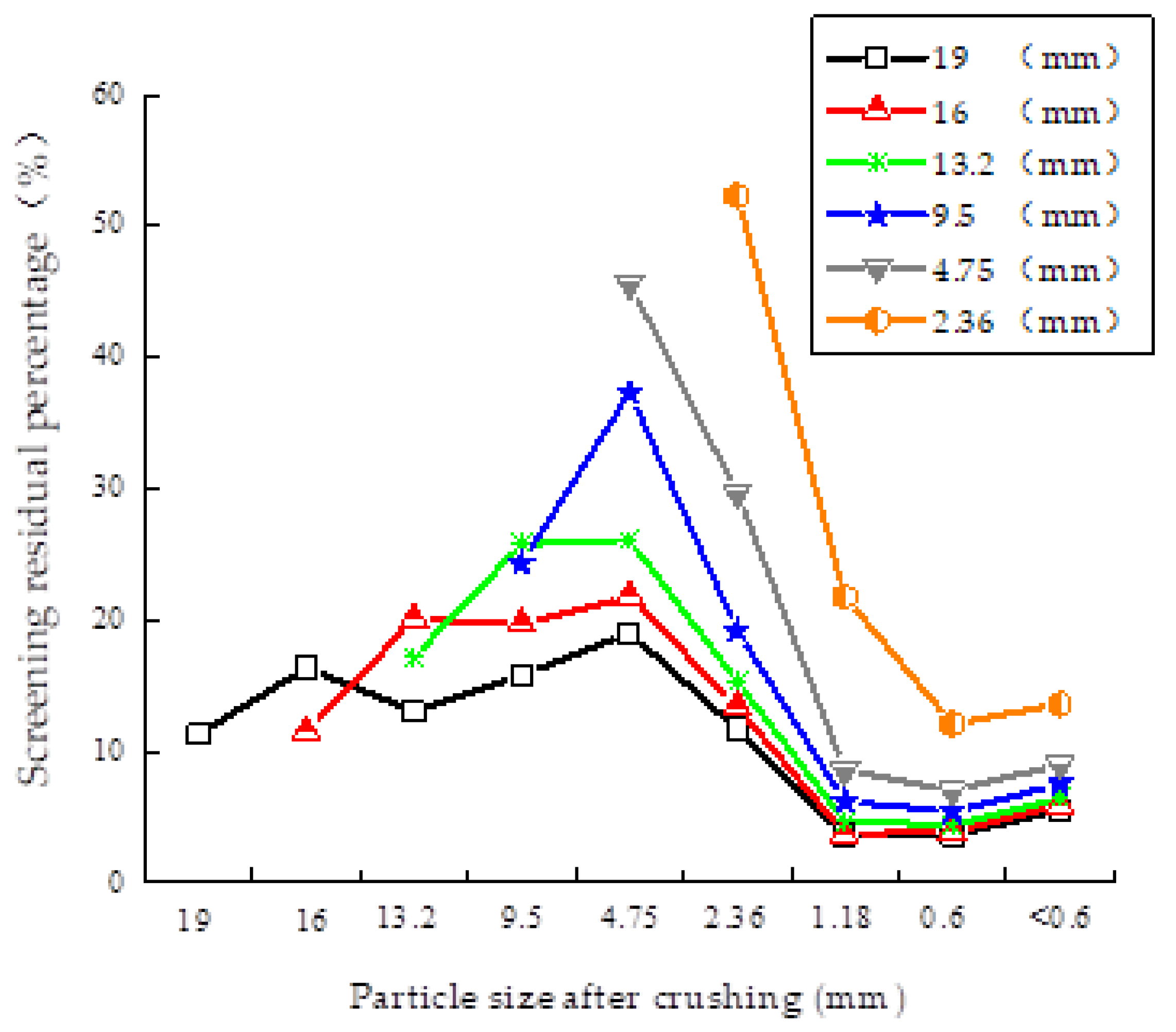
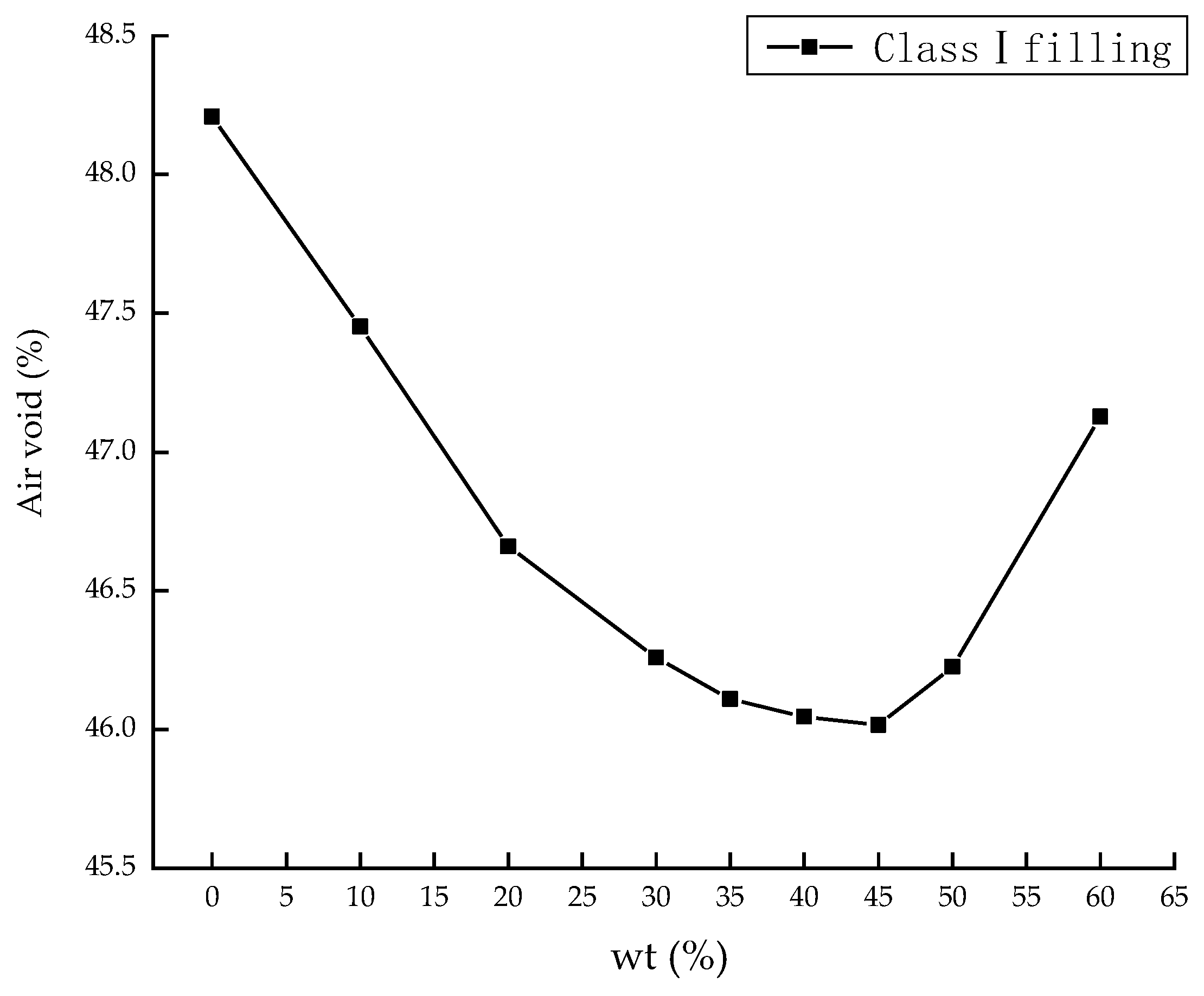
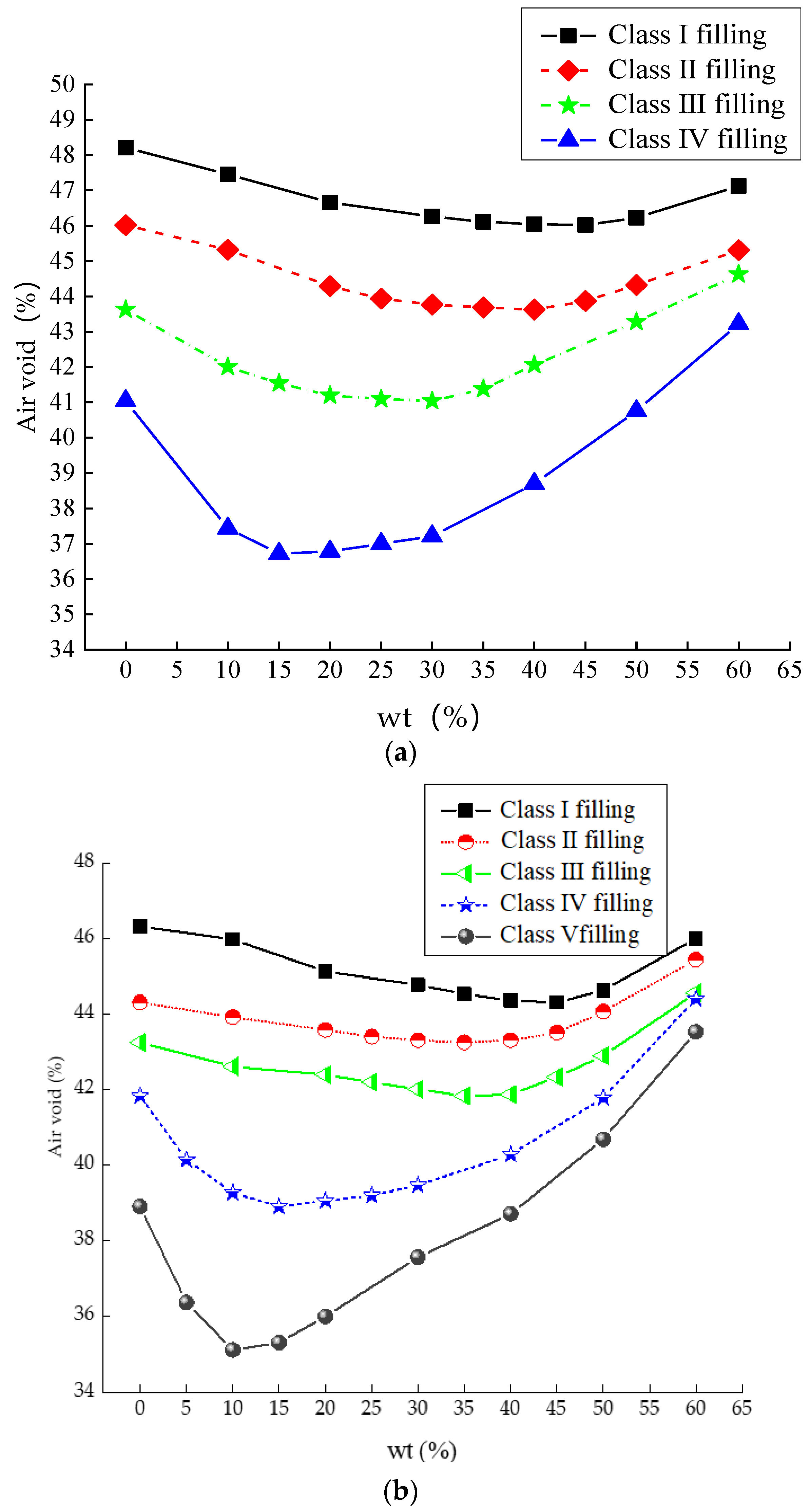
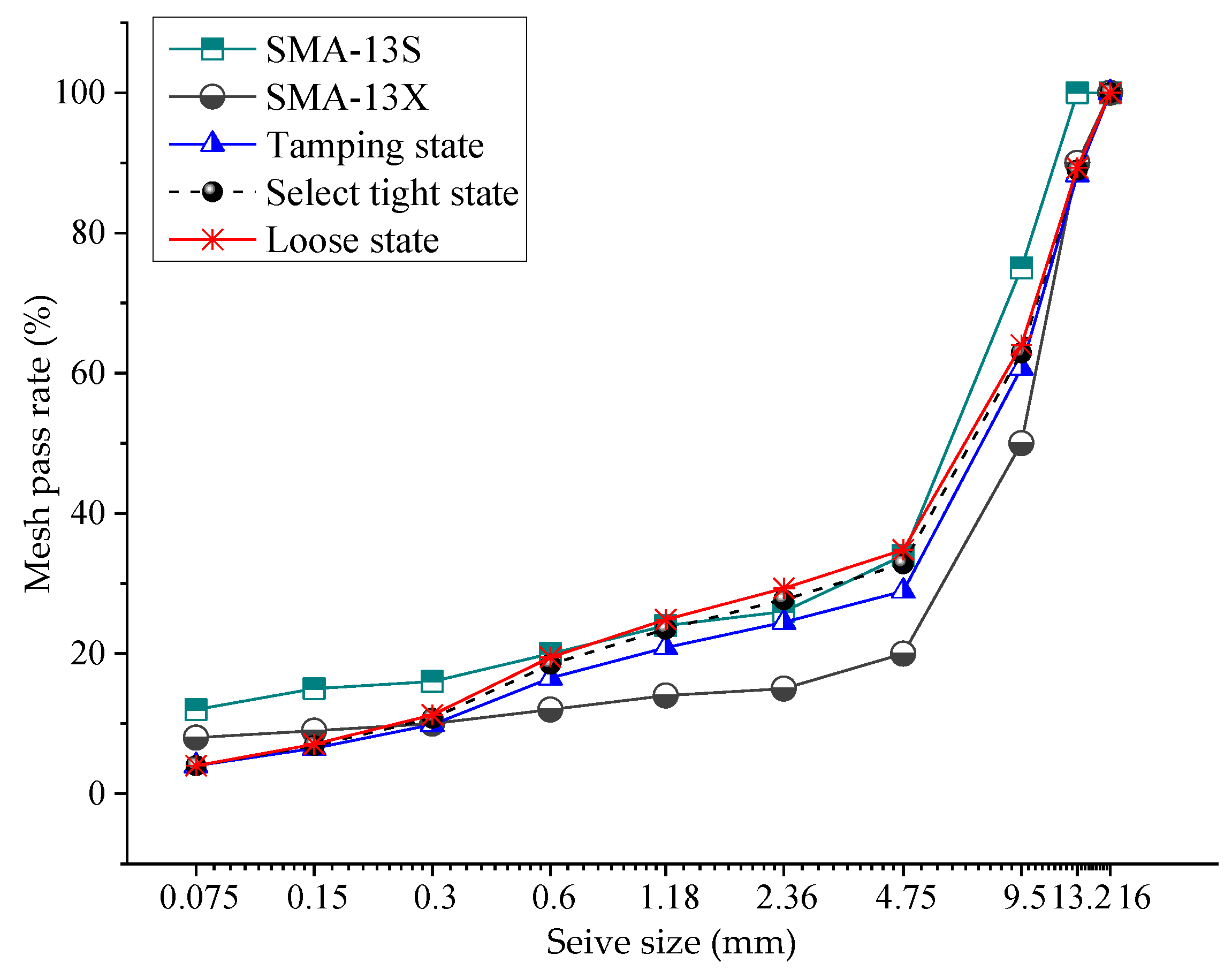
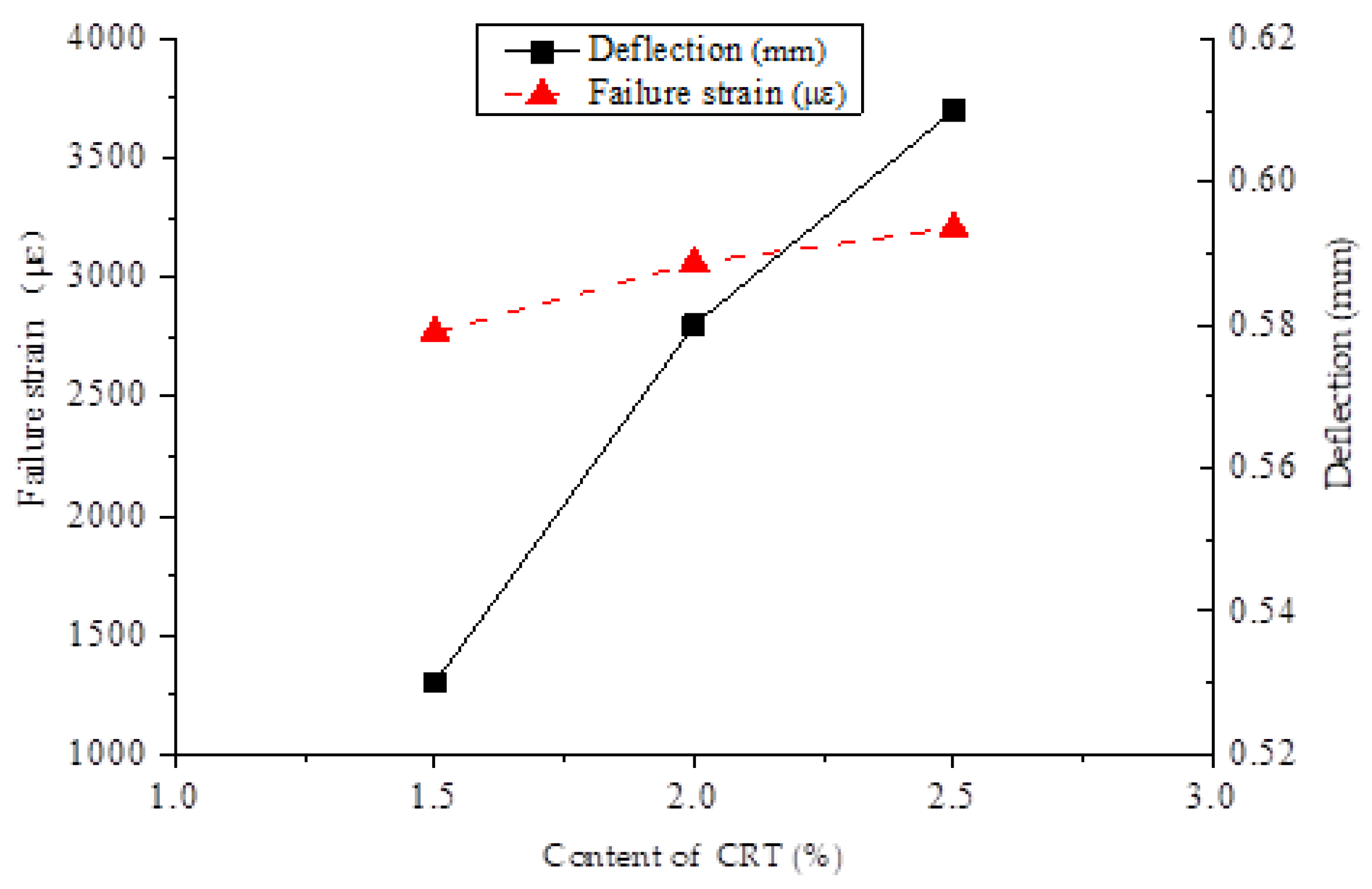
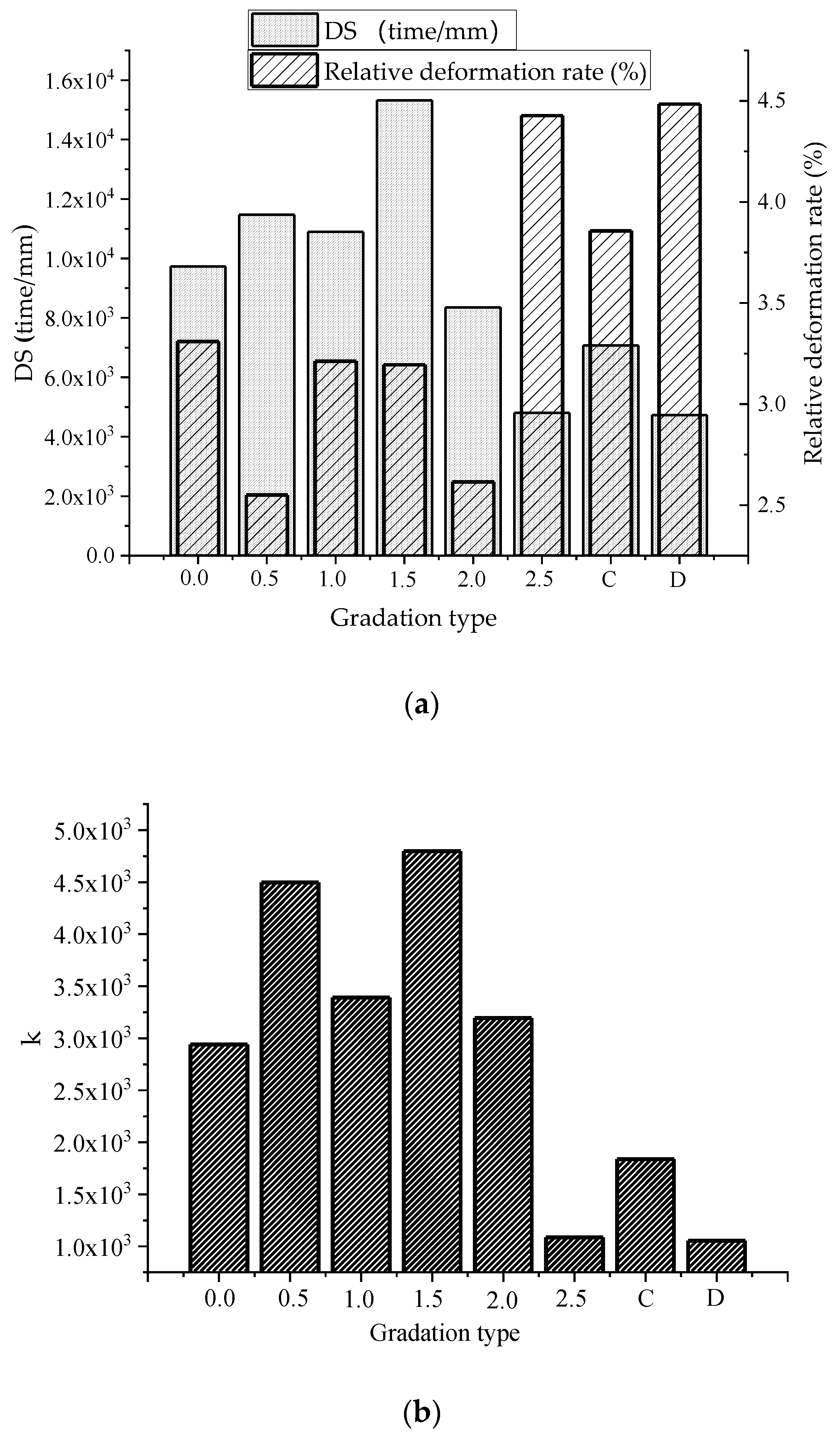
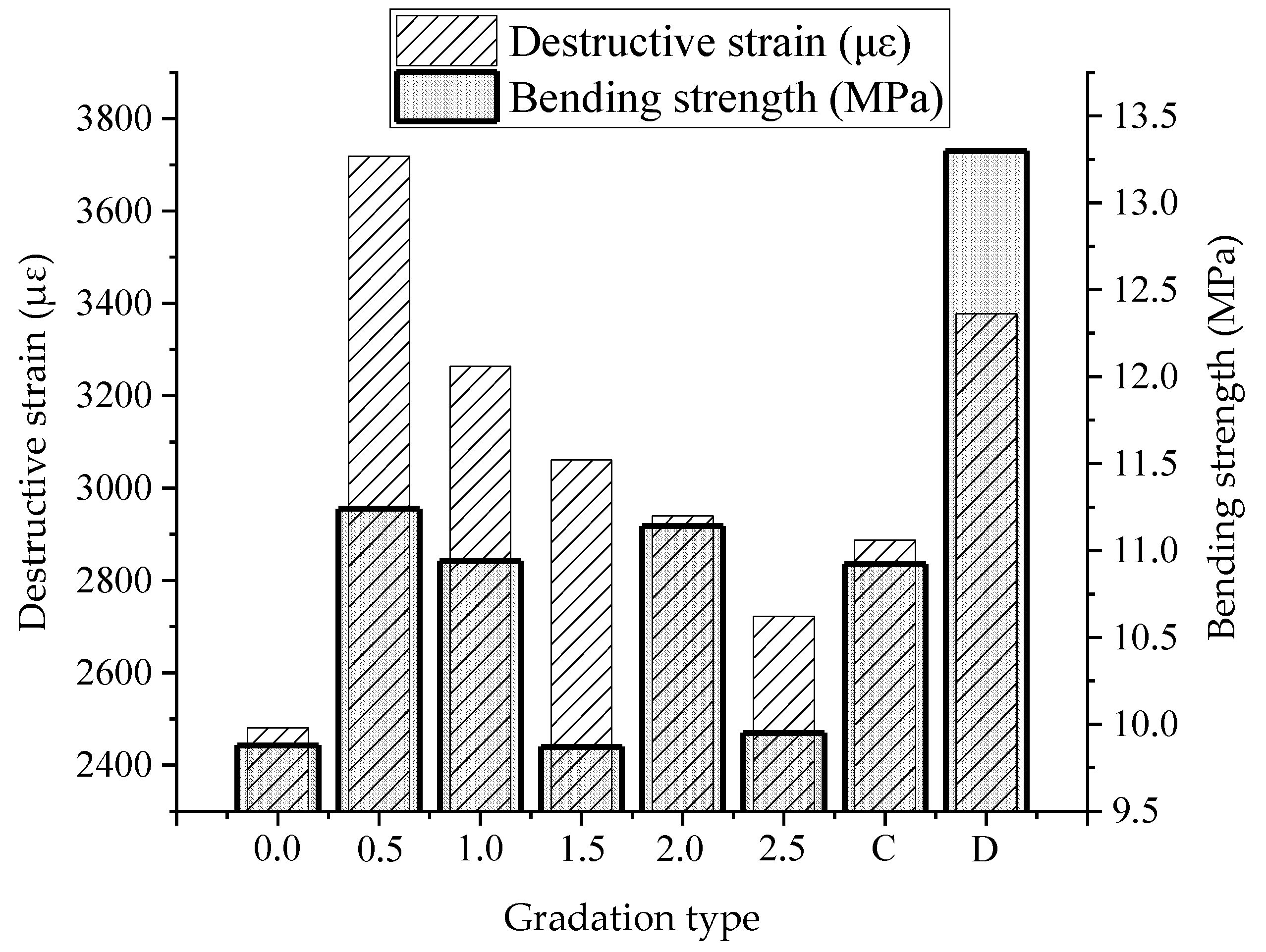
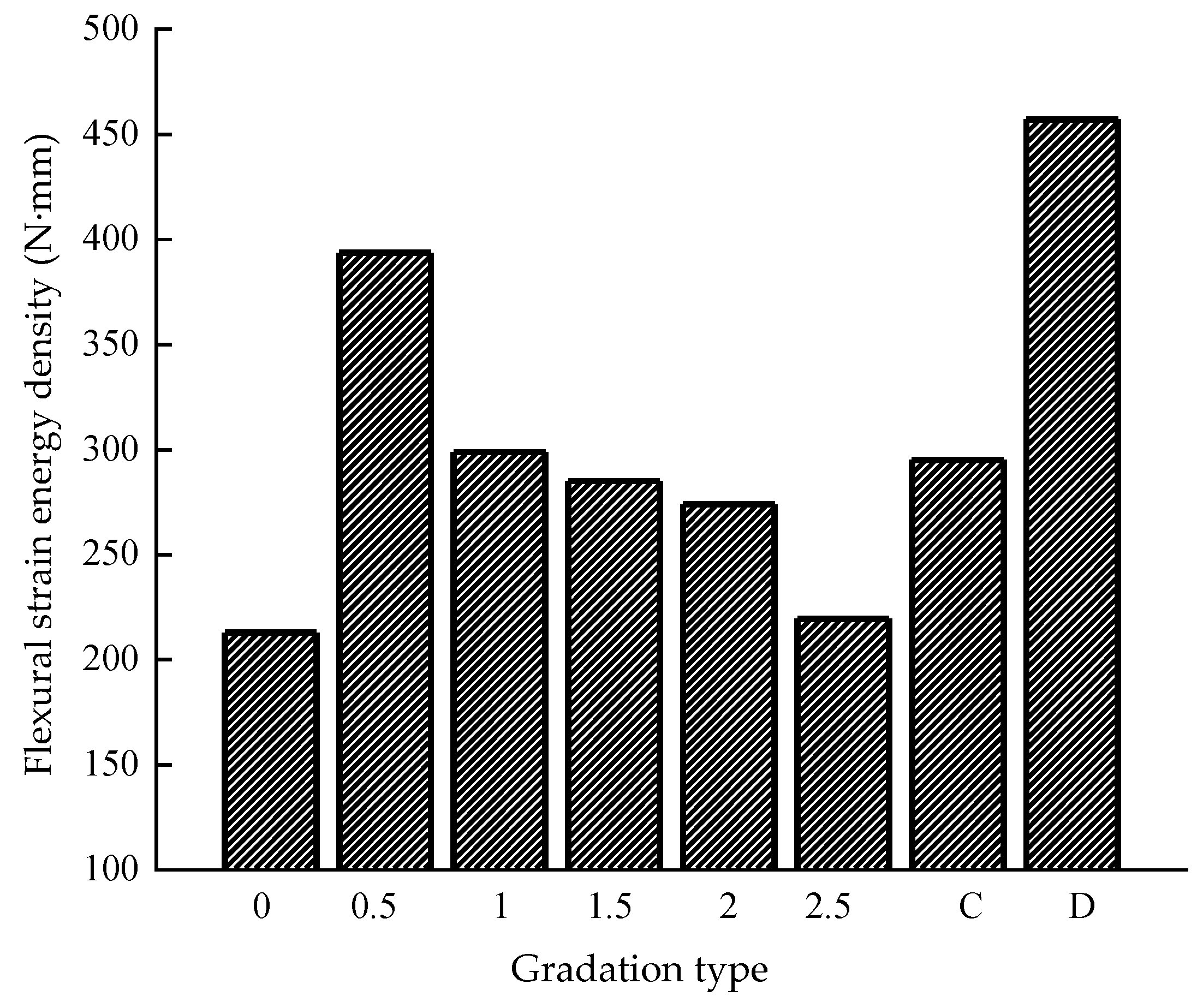

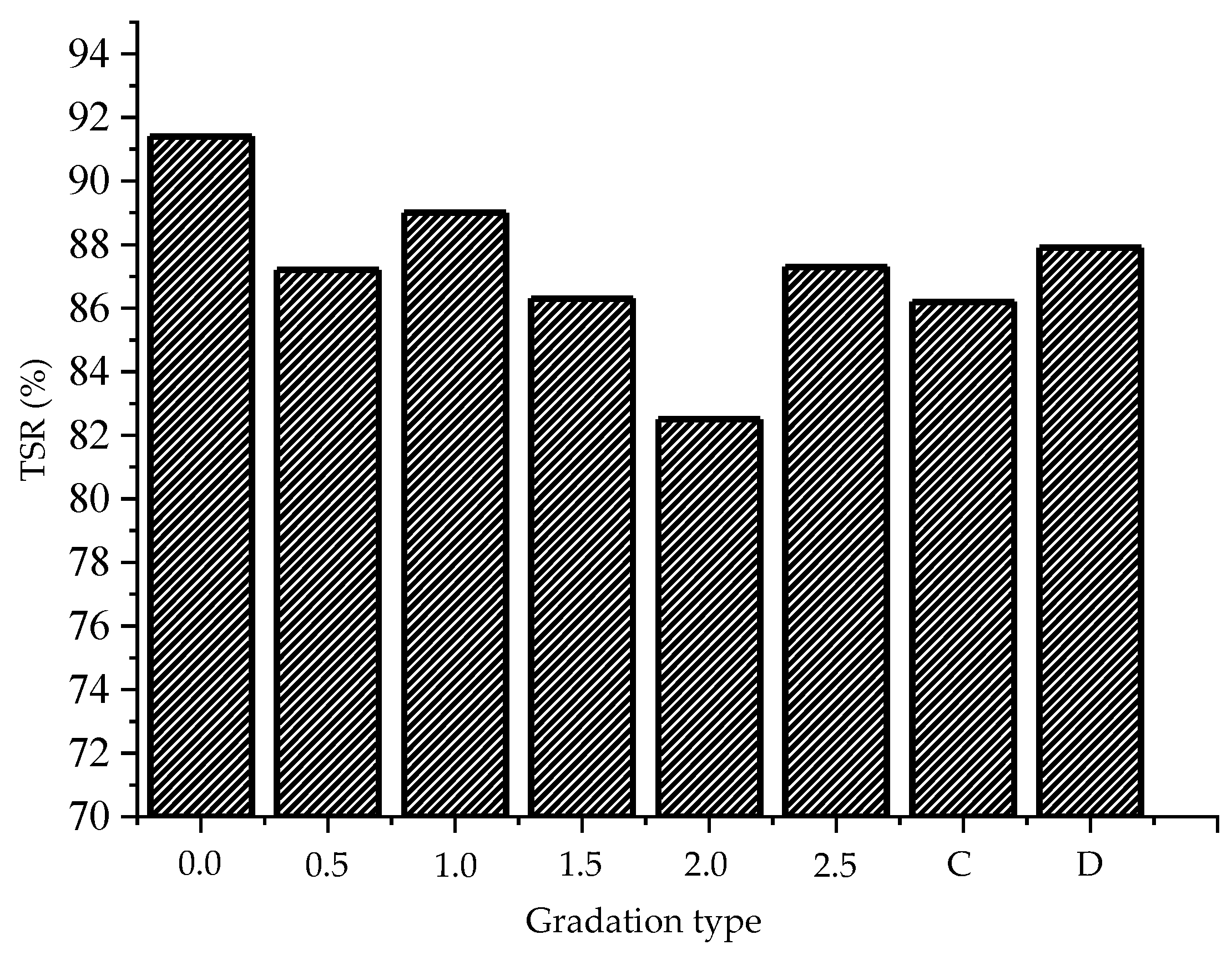
| Items | Units | Test Results | Specification Limits | |
|---|---|---|---|---|
| Penetration (25 °C, 100 g, 5 s) | 0.1 m | 88.2 | 80–100 | |
| Ductility (5 cm/min, 15 °C) | cm | 128.8 | ≥100 | |
| Ductility (5 cm/min, 10 °C) | cm | 34.6 | ≥20 | |
| Softening point (righ and ball method) | °C | 46.5 | ≥45 | |
| Flash point (COC) | °C | 297 | ≥245 | |
| Wax content (distillation method) | % | 1.9 | ≤2.2 | |
| Density (15 °C) | g/cm3 | 0.99 | — | |
| Solubility (trichloroethylene) | % | 99.6 | ≥99.5 | |
| The thin film oven test (TFOT) (163 °C, 5 h) | Residual penetration ratio | % | 73.6 | ≥57 |
| Ductility (5 cm/min, 15 °C) | cm | >100 | ≥20 | |
| Ductility (5 cm/min, 10 °C) | cm | 8.26 | ≥8 | |
| Materials | Properties | Units | Specification Limits | Test Result | |
|---|---|---|---|---|---|
| Surface Layer | Other Layers | ||||
| Coarse aggregate | Stone crushing value | % | ≥26 | ≥28 | 12.5 |
| Los Angeles wear loss | % | ≥28 | ≥30 | 16.0 | |
| Apparent relative density | % | ≥2.60 | ≥2.50 | 2.8 | |
| Water absorption rate | % | ≥2.0 | ≥3.0 | 0.90 | |
| Rugged | % | ≥12 | ≥12 | 6.0 | |
| Needle-like particle content (mixture) Particle size greater than 9.5 mm Particle size less than 9.5 mm | % | ≥15 ≥12 ≥18 | ≥18 ≥15 ≥20 | 6.8 | |
| Particle content <0.075 mm through washing method | % | ≥1 | ≥1 | 4.2 | |
| Soft stone content | % | ≥3 | ≥5 | 8.8 | |
| Filler | Apparent density | g/cm3 | ≥2.5 | 2.724 | |
| Particle size range <0.6 mm <0.15 mm <0.075 mm | % | 100 90–100 80–100 | 100 99.8 85.3 | ||
| Hydrophilic coefficient | — | <1 | 0.58 | ||
| Water content | % | ≤1 | 0.1 | ||
| Plasticity index | — | <4 | 3.3 | ||
| Density | Aggregate Specification (mm) | ||||||||
|---|---|---|---|---|---|---|---|---|---|
| 13.2 | 9.5 | 4.75 | 2.36 | 1.18 | 0.6 | 0.3 | 0.15 | 0.075 | |
| Apparent relative density | 2.896 | 2.940 | 2.807 | 2.841 | — | — | — | — | — |
| Bulk volume relative density | 2.779 | 2.870 | 2.773 | 2.757 | — | — | — | — | — |
| Apparent relative density | — | — | — | — | 2.822 | 2.791 | 2.796 | 2.834 | 2.805 |
| Materials | Properties | Units | Specification Limits | Test Results |
|---|---|---|---|---|
| CRT | Relative density | g/cm3 | — | 1.21 |
| Water content | % | <1.0 | 0.53 | |
| Metal content | % | <0.01 | 0.004 | |
| Fiber content | % | <1.0 | 0.003 | |
| CR | Relative density | g/cm3 | 1.10–1.30 | 1.20 |
| Water content | % | <1.0 | 0.56 | |
| Metal content | % | <0.05 | 0.016 | |
| Fiber content | % | <1.0 | 0.0 | |
| Ash content | % | ≤8 | 3.9 | |
| Acetone extract | % | ≤22 | 14 | |
| Carbon black content | % | ≥28 | 40 |
| Sieve Size (mm) | 2.36 | 1.18 | 0.6 | 0.3 | 0.15 | 0.075 |
|---|---|---|---|---|---|---|
| Percentage passing (%) | 100 | 90.34 | 70.23 | 38.66 | 10.3 | 1.23 |
| Gradation Types | Particle Size Range (mm) | Proportion (%) | Density (kg/m3) | Air Void (%) | ||||
|---|---|---|---|---|---|---|---|---|
| Tamping State | Select Tight State | Loose State | Tamping State | Select Tight State | Loose State | |||
| Gradation 1 | 16–13.2 | 10.7 | 1.683 | 1.573 | 1.527 | 39.858 | 43.809 | 45.444 |
| 13.2–9.5 | 28.4 | |||||||
| 9.5–4.75 | 48.1 | |||||||
| 4.74–2.36 | 12.8 | |||||||
| Gradation 2 | 16–13.2 | 16.5 | 1.696 | 1.604 | 1.557 | 39.675 | 42.941 | 44.601 |
| 13.2–9.5 | 38.8 | |||||||
| 9.5–4.75 | 44.8 | |||||||
| Projects | Units | Different Composition Ratios of 2.36–1.18-mm and 1.18–0.6-mm Aggregates | ||||||||
|---|---|---|---|---|---|---|---|---|---|---|
| 10:0 | 9:1 | 8:2 | 7:3 | 6.5:3.5 | 6:4 | 5.5:4.5 | 5:5 | 4:6 | ||
| Aggregate quality | g | 1520 | 1540.5 | 1562 | 1572 | 1575.5 | 1576.5 | 1576.6 | 1569.5 | 1541.5 |
| Tight density | g/cm3 | 1.462 | 1.481 | 1.502 | 1.512 | 1.515 | 1.516 | 1.516 | 1.509 | 1.482 |
| Apparent density | g/cm3 | 2.822 | 2.819 | 2.816 | 2.813 | 2.811 | 2.810 | 2.808 | 2.806 | 2.803 |
| Air void | % | 48.209 | 47.452 | 46.660 | 46.259 | 46.109 | 46.045 | 46.016 | 46.226 | 47.127 |
| Gradation Types | Particle Size Range (mm) | Proportion (%) | Synthetic Apparent Density (g/cm3) | Tight Density (g/cm3) | Air Void (%) |
|---|---|---|---|---|---|
| Gradation 1 | 2.36–1.18 | 19.64 | 2.811 | 1.779 | 36.724 |
| 1.18–0.6 | 16.07 | ||||
| 0.6–0.3 | 23.80 | ||||
| 0.3–0.15 | 25.50 | ||||
| 0.15–0.075 | 15.00 | ||||
| Gradation 2 | 4.75–2.36 | 17.78 | 2.813 | 1.825 | 35.118 |
| 2.36–1.18 | 14.54 | ||||
| 1.18–0.6 | 17.40 | ||||
| 0.6–0.3 | 26.78 | ||||
| 0.3–0.15 | 13.50 | ||||
| 0.15–0.075 | 10.00 |
| Gradation | State | X (%) | Y (%) | Z (%) |
|---|---|---|---|---|
| 1 | Tamping state | 70.8 | 24.2 | 4.58 |
| Select tight state | 66.1 | 28.9 | 4.58 | |
| Loose state | 64.2 | 30.8 | 4.58 | |
| 2 | Tamping state | 71.1 | 24.9 | 4.56 |
| Select tight state | 67.2 | 28.8 | 4.56 | |
| Loose state | 65.2 | 30.8 | 4.56 |
| Gradation | Particle Size (mm) | 16 | 13.2 | 9.5 | 4.75 | 2.36 | 1.18 | 0.6 | 0.3 | 0.15 | 0.075 |
|---|---|---|---|---|---|---|---|---|---|---|---|
| 1 | Tamping state | 100.00 | 92.42 | 72.34 | 38.28 | 29.20 | 24.45 | 20.56 | 14.80 | 8.63 | 5.00 |
| Select tight state | 100.00 | 92.92 | 74.18 | 42.38 | 33.90 | 28.23 | 23.58 | 16.70 | 9.34 | 5.00 | |
| Loose state | 100.00 | 93.13 | 74.92 | 44.03 | 35.80 | 29.75 | 24.80 | 17.47 | 9.62 | 5.00 | |
| 2 | Tamping state | 100.00 | 88.30 | 60.75 | 28.90 | 24.47 | 20.85 | 16.52 | 9.85 | 6.49 | 4.00 |
| Select tight state | 100.00 | 88.95 | 62.90 | 32.80 | 27.68 | 23.49 | 18.48 | 10.77 | 6.88 | 4.00 | |
| Loose state | 100.00 | 89.27 | 64.01 | 34.80 | 29.32 | 24.85 | 19.48 | 11.24 | 7.08 | 4.00 |
| Project | Gradation 1 | Gradation 2 | |||
|---|---|---|---|---|---|
| Tamping State | Selected Tight State | Tamping State | Selected Tight State | Loose State | |
| P2.9 | 31.29 | 35.85 | 25.49 | 28.86 | 30.58 |
| P6.6 | 51.56 | 54.78 | 41.32 | 44.54 | 46.19 |
| RCA | 0.42 | 0.42 | 0.27 | 0.28 | 0.29 |
| Specification limits | 0.26–0.41 | ||||
| Content of CRT (%) | Mass Percentage (%) through Sieve Pore (mm) | |||||||||
|---|---|---|---|---|---|---|---|---|---|---|
| 16 | 13.2 | 9.5 | 4.75 | 2.36 | 1.18 | 0.6 | 0.3 | 0.15 | 0.075 | |
| 1.5 | 100.00 | 88.57 | 61.61 | 30.46 | 25.16 | 20.83 | 15.64 | 9.74 | 6.77 | 4.14 |
| 2 | 100.00 | 88.44 | 61.18 | 29.68 | 24.32 | 19.94 | 14.70 | 9.40 | 6.74 | 4.19 |
| 2.5 | 100.00 | 88.31 | 60.75 | 28.90 | 23.48 | 19.05 | 13.75 | 9.06 | 6.70 | 4.23 |
| Substitution Ratios | Mass Percentage (%) through Sieve Pore (mm) | |||||||||
|---|---|---|---|---|---|---|---|---|---|---|
| 16 | 13.2 | 9.5 | 4.75 | 2.36 | 1.18 | 0.6 | 0.3 | 0.15 | 0.075 | |
| 0 | 100.00 | 88.94 | 62.90 | 32.80 | 27.68 | 23.49 | 18.48 | 10.77 | 6.88 | 4.00 |
| 0.5 | 100.00 | 88.69 | 62.05 | 31.24 | 26.00 | 21.72 | 16.59 | 10.09 | 6.81 | 4.09 |
| 1 | 100.00 | 88.44 | 61.18 | 29.68 | 24.33 | 19.94 | 14.70 | 9.40 | 6.74 | 4.19 |
| 1.5 | 100.00 | 88.18 | 60.32 | 28.12 | 22.65 | 18.16 | 12.81 | 8.72 | 6.66 | 4.28 |
| 2 | 100.00 | 87.92 | 59.46 | 26.56 | 20.97 | 16.39 | 10.91 | 8.03 | 6.59 | 4.37 |
| 2.5 | 100.00 | 87.67 | 58.60 | 25.00 | 19.29 | 14.61 | 9.02 | 7.35 | 6.52 | 4.46 |
| C | 100.00 | 88.47 | 61.28 | 29.86 | 24.52 | 24.52 | 19.29 | 11.24 | 7.18 | 4.17 |
| D | 100.00 | 88.35 | 60.90 | 29.17 | 29.17 | 24.76 | 19.48 | 11.35 | 7.25 | 4.22 |
| Type | OAC (%) | VCADRC (%) | VCAmix (%) | VCADLC (%) | S (%) | Proportion of Coarse Aggregate (%) |
|---|---|---|---|---|---|---|
| 0 | 4.7 | 39.666 | 43.901 | 44.610 | 96.2 | 67.19 |
| 0.5 | 4.84 | 42.544 | 98.4 | 68.76 | ||
| 1 | 4.93 | 41.216 | 100.6 | 70.32 | ||
| 1.5 | 5.03 | 40.014 | 102.5 | 71.88 | ||
| 2 | 5.16 | 38.921 | 104.3 | 73.44 | ||
| 2.5 | 5.23 | 37.757 | 106.2 | 75.00 | ||
| C | 4.43 | 41.292 | 101.0 | 70.14 | ||
| D | 4.79 | 40.766 | 101.5 | 70.82 |
© 2020 by the authors. Licensee MDPI, Basel, Switzerland. This article is an open access article distributed under the terms and conditions of the Creative Commons Attribution (CC BY) license (http://creativecommons.org/licenses/by/4.0/).
Share and Cite
Ma, F.; Dai, J.; Fu, Z.; Liu, J.; Dong, W.; Huang, Z. A New Type of Crumb Rubber Asphalt Mixture: A Dry Process Design and Performance Evaluation. Appl. Sci. 2020, 10, 372. https://doi.org/10.3390/app10010372
Ma F, Dai J, Fu Z, Liu J, Dong W, Huang Z. A New Type of Crumb Rubber Asphalt Mixture: A Dry Process Design and Performance Evaluation. Applied Sciences. 2020; 10(1):372. https://doi.org/10.3390/app10010372
Chicago/Turabian StyleMa, Feng, Jiasheng Dai, Zhen Fu, Jenny Liu, Wenhao Dong, and Zhen Huang. 2020. "A New Type of Crumb Rubber Asphalt Mixture: A Dry Process Design and Performance Evaluation" Applied Sciences 10, no. 1: 372. https://doi.org/10.3390/app10010372




